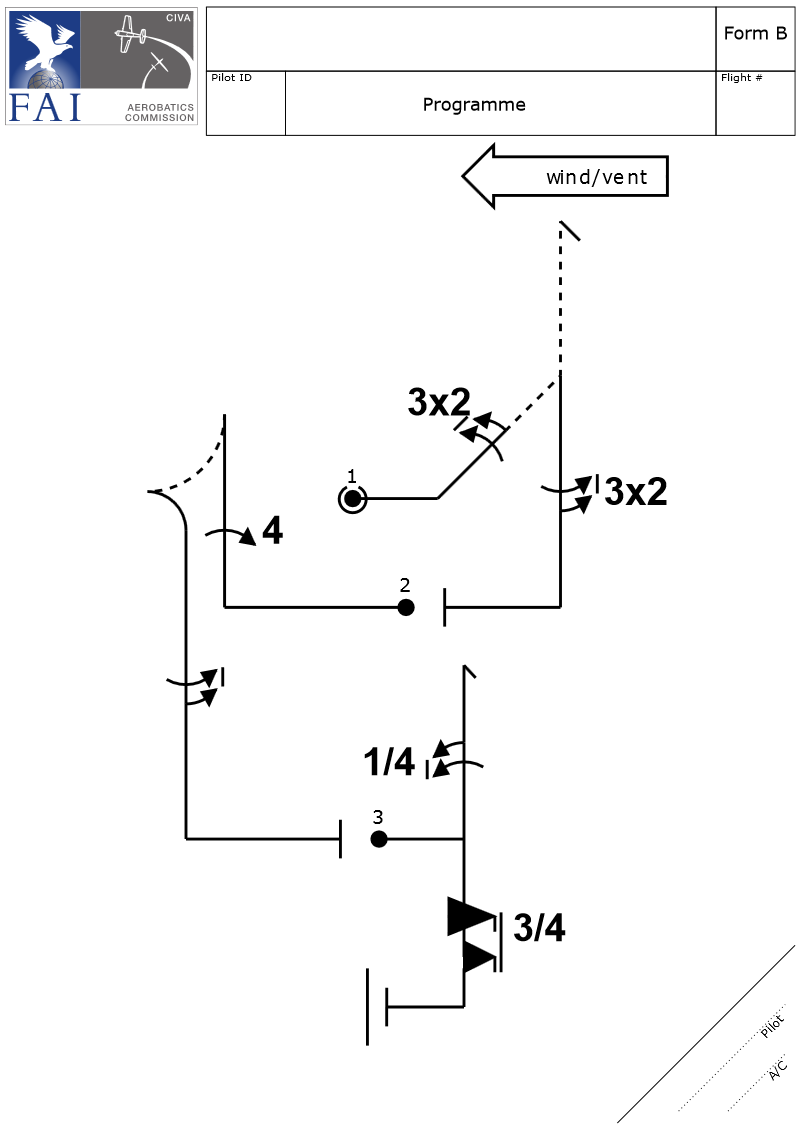The changing styles
of aerobatics
Aerobatics is not a
stagnant sport. The rules evolve and change. The aircraft
available change also, more power, more roll rate - more of
everything. New pilots also come along with new ideas. While the
core figures and elements may not change a whole lot, the
combinations of them and where they are placed in the sequence
definitely change.
Fig.1
Unlimited Frees from
the 70’s (Fig.1 Zlin 526) and early 80’s (Fig.2 Henry
Haigh, Haigh Superstar 1988 Free) look like extended
Intermediate sequences to today’s eyes.
Fig.2
The number of figures
allowed in the Free was reduced to 9 sometime after this, and
sequences from the early 90’s are quite similar to today. In the
late 90’s a bonus point system was introduced for Frees with fewer
than 9 figures. This led to amazingly complex 7 figure Frees that
were very busy to fly, and also made rational judging a superhuman
task. (Fig.3 Cassidy Free 1999, CAP-222).
Fig.3
This experiment was
dropped and the 9 figure Unlimited Free returned. This does not
mean change has stopped, however (Fig.4 Mamistov Free 2008, Su-26M3).
Fig.4
A smart sequences with
an even spread of K and designed to minimize losses. One exception
would be the use of a full 4-roll rolling circle. It is difficult
to get a good score on any roller, so usual practice would be to use
the lowest K roller possible, and place it late in the sequence so as
not to colour the judges’ opinion of other figures. Mamistov’s
later 2011 and 2013 sequences did change the roller for a simpler
one, influenced no doubt by the 2010 increase in K for all rollers.
Similar comments may be made about the super-eight figure – lots
of steady looping segments and 45’s with rolls to be centred. The
figure is slow flying and allows judges to nit pick many elements, so
hard to score well with. On the other hand it is a relatively easy
figure to practice and refine to perfection, as Mamistov, twice
powered world champion, obviously does.
Often recommended when
designing a Free is to start with a killer figure at VNE and zoom to
the moon – and this is the usual practice today. It conforms with
the traditional approach of starting with lots of energy, assuming
you will have less as you progress through the sequence (Fig.5 Le Vot
WAC 2013 Free).
Fig.5
But this doesn’t suit
everyone, particularly if you are ‘slow starter’ and take a
figure or two to settle and get into the groove. If this is you, it
may be better to start with a technically simpler figure and build
through the flight (Fig.6 Cooper Free WAC 2013).
Fig.6
Supporting this
‘cautious’ approach is the fact you don’t get any chance to
practice your start in the Free Programme – just the safeties and
then straight into it. You should also consider that at a large
International comp you may have to wait days between the Known and
the Free – how current and fresh will you feel when your 15 minutes
of fame comes?
That said, I think you
can see a definite shift in Free design (the exception that proves
the rule?). Possibly this latest move can be attributed to Renaud
Ecalle and his Free of 2010 (Fig.7).
Fig.7
The horizontal start
figure, able to be flown at the bottom of the box, is the defining
characteristic of the new design style. Then the sequence climbs up
for the spin and tailslide, and back down to finish with a minimalist
roller at the bottom of the box. Maintaining energy throughout the
sequence is not the concern it once was. These types of figures are
also appearing more often elsewhere in sequences. Here is another
start figure (Fig.8):
Fig.8
Accuracy and confidence
are needed to make these explosive starts work for you (and no little
amount of skill). Only 4 of the 57 Frees at the last WAC began with
similar low rolling figures. Notable proponents were Holland,
Thomas and Boerbon (2nd, 4th and 8th in the
Free, respectively, USA). It doesn’t suit everyone, and it needs
to be executed flawlessly. Maybe it is a risk that needs to be
taken only if you are gunning for the World Title?









1 comment:
nice info!
br,
inklusi
Post a Comment